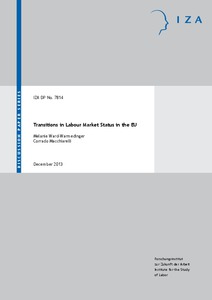Transitions in labour market status in the EU
"This paper presents information on labour market mobility in 23 EU countries, using Eurostat's Labour Force Survey (LFS) data over the period 1998-2008. More specifically, it discusses alternative measures of labour market churning; including the ease with which individuals can move betwe...
| Main Authors: | , |
|---|---|
| Institution: | ETUI-European Trade Union Institute |
| Format: | TEXT |
| Language: | English |
| Published: |
Bonn
2013
IZA |
| Subjects: | |
| Online Access: | https://www.labourline.org/KENTIKA-19121444124919496269-Transitions-in-labour-market-s.htm |
| Summary: | "This paper presents information on labour market mobility in 23 EU countries, using Eurostat's Labour Force Survey (LFS) data over the period 1998-2008. More specifically, it discusses alternative measures of labour market churning; including the ease with which individuals can move between employment, unemployment and inactivity over time. The results suggest that the probability of remaining in the same labour market status between two consecutive periods is high for all countries. Nonetheless, transitions from unemployment and inactivity back into the labour market are relatively weak in the euro area and central eastern European EU (CEE EU) countries compared to Denmark and, particularly, Sweden. Moreover, comparisons of transition probabilities over time suggest that – until the onset of the financial crisis – the probability of remaining in unemployment over two consecutive periods decreased in Sweden, the euro area, and, to a lesser extent, Denmark, while it increased in the average CEE EU countries. At the same time, however, successful labour market entries (from outside the labour market) increased in the average CEE EU countries, Denmark and Sweden. On the basis of an index for labour markets turnover used in the paper (Shorrocks, 1987), labour markets in Spain, Luxemburg, the Netherlands, Denmark and Sweden are the most mobile on average, with these results mainly reflecting higher mobility of people below the age of 29, highly educated and female workers. We also find that mobility of all worker groups has generally increased over time in the euro area, Denmark and Sweden. Finally, we ask whether some of the observed changes in mobility can be broadly restraint to some "macro" explanatory factors, including part time and temporary employment, unemployment and structure indicators. The results provide a mixed picture, suggesting that the sense of mobility strongly varies across countries." |
|---|---|
| Physical Description: | 32 p. Digital |

